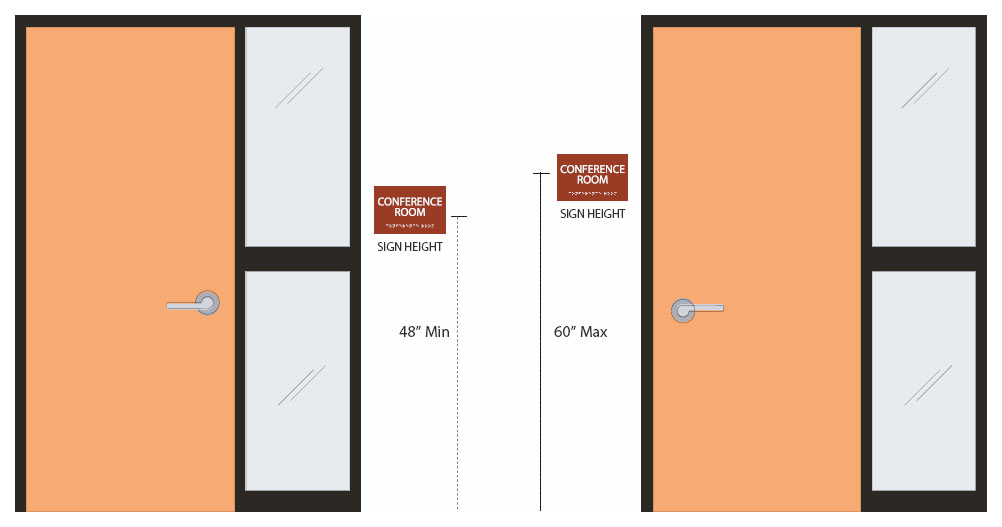Just How ADA Signs Boost Access for Everyone
Just How ADA Signs Boost Access for Everyone
Blog Article
Checking Out the Key Features of ADA Signs for Enhanced Accessibility
In the world of accessibility, ADA indications serve as silent yet powerful allies, ensuring that spaces are comprehensive and accessible for individuals with impairments. By integrating Braille and tactile components, these indicators damage obstacles for the visually damaged, while high-contrast color schemes and legible fonts accommodate diverse aesthetic needs. Additionally, their tactical positioning is not approximate yet instead a calculated effort to assist in seamless navigating. Yet, beyond these functions exists a much deeper narrative concerning the development of inclusivity and the recurring commitment to creating fair spaces. What extra could these indicators signify in our pursuit of universal access?
Value of ADA Conformity
Making certain conformity with the Americans with Disabilities Act (ADA) is essential for cultivating inclusivity and equal gain access to in public rooms and offices. The ADA, established in 1990, mandates that all public facilities, employers, and transport solutions fit people with disabilities, guaranteeing they take pleasure in the very same legal rights and possibilities as others. Conformity with ADA criteria not only satisfies legal responsibilities yet likewise enhances a company's online reputation by showing its dedication to diversity and inclusivity.
One of the essential aspects of ADA compliance is the implementation of available signs. ADA indications are created to make certain that people with specials needs can conveniently browse via structures and areas. These indications need to follow particular standards concerning dimension, font, shade contrast, and positioning to assure exposure and readability for all. Correctly executed ADA signs assists remove barriers that people with disabilities usually come across, therefore promoting their independence and confidence (ADA Signs).
Furthermore, sticking to ADA policies can minimize the danger of legal repercussions and potential penalties. Organizations that stop working to adhere to ADA guidelines might face legal actions or charges, which can be both financially burdensome and damaging to their public picture. Hence, ADA conformity is indispensable to promoting a fair setting for every person.
Braille and Tactile Elements
The consolidation of Braille and tactile elements into ADA signs symbolizes the principles of availability and inclusivity. These features are crucial for individuals that are aesthetically impaired or blind, enabling them to navigate public rooms with greater self-reliance and confidence. Braille, a responsive writing system, is vital in giving composed information in a style that can be conveniently viewed through touch. It is commonly placed under the equivalent message on signage to make certain that individuals can access the info without aesthetic aid.
Tactile components expand beyond Braille and include elevated symbols and personalities. These parts are created to be discernible by touch, permitting individuals to identify area numbers, washrooms, exits, and various other critical locations. The ADA sets particular standards pertaining to the size, spacing, and positioning of these tactile aspects to optimize readability and make certain uniformity across various environments.

High-Contrast Shade Plans
High-contrast color design play a pivotal role in boosting the presence and readability of ADA signs for people with visual impairments. These schemes are vital as they optimize the distinction in light reflectance in between text and history, making certain that signs are conveniently discernible, even from a range. The Americans with Disabilities Act (ADA) mandates making use of certain shade contrasts to accommodate those with minimal vision, making it an essential aspect of conformity.
The effectiveness of high-contrast colors depends on their capability to stand apart in different lights conditions, including poorly lit atmospheres and areas with glow. Commonly, dark text on a light history or light message on a dark history is utilized to attain ideal contrast. As an example, black text on a white or yellow background offers a stark visual difference that assists in quick recognition and understanding.

Legible Fonts and Text Dimension
When taking into consideration the style of ADA signage, the option of legible Homepage fonts and appropriate text size can not be overemphasized. The Americans with Disabilities Act (ADA) mandates that fonts should be not italic and sans-serif, oblique, script, very decorative, or of uncommon kind.
According to ADA guidelines, the minimum text elevation ought to be 5/8 inch, and it should enhance proportionally with viewing range. Consistency in text dimension contributes to a cohesive visual experience, helping individuals in navigating atmospheres efficiently.
In addition, spacing in between lines and letters is indispensable to clarity. Appropriate spacing prevents characters from showing up crowded, enhancing readability. By sticking to these criteria, developers can significantly improve availability, making certain that signs offers its intended function for all individuals, no matter their aesthetic capabilities.
Efficient Positioning Techniques
Strategic positioning of ADA signs is crucial for maximizing ease of access and ensuring compliance with legal requirements. ADA guidelines state that indicators should be placed at a height in between 48 to 60 inches from the ground to guarantee they are within the line of view for both standing and seated people.
Additionally, their website signs must be put nearby to the lock side of doors to permit very easy recognition before entry. This positioning helps individuals locate areas and spaces without blockage. In instances where there is no door, indications should be positioned on the nearby surrounding wall. Consistency in sign placement throughout a center enhances predictability, minimizing complication and boosting overall individual experience.

Verdict
ADA signs play a crucial duty in promoting availability by incorporating attributes that resolve the requirements of individuals with handicaps. These aspects collectively promote a comprehensive setting, emphasizing the value of ADA compliance in making sure equivalent gain access to for all.
In the realm of accessibility, ADA indicators offer as quiet yet powerful allies, ensuring that spaces are visit this website accessible and comprehensive for people with handicaps. The ADA, passed in 1990, mandates that all public centers, employers, and transportation solutions suit people with handicaps, guaranteeing they delight in the exact same civil liberties and possibilities as others. ADA Signs. ADA signs are created to make certain that individuals with handicaps can easily browse with structures and areas. ADA guidelines stipulate that indications should be installed at an elevation between 48 to 60 inches from the ground to ensure they are within the line of view for both standing and seated people.ADA indicators play a crucial role in promoting access by incorporating functions that address the demands of people with specials needs
Report this page